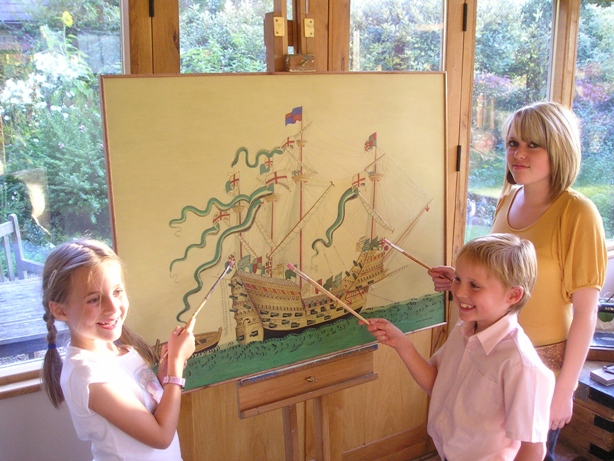Tactile Art
In 2005 Heather Bowring met an elderly lady who had lost her sight late in life. In conversation, Heather asked her about her blindness and where she went to feel works of art.
The woman replied: “I don’t go anywhere my dear, because you are not allowed to touch anything.”
Heather had begun painting the year before and that remark inspired her to step up to the challenge of finding a way to adapt fine plaster to allow her to paint with it, allowing it to be tough enough to be touched.
Tate Modern
In less than three years, Heather had two solo exhibitions and received her first commission from the Touch Tours Department of the Tate Modern.
Tate Modern’s Interpretation and Education Department has commissioned a raised tactile art image painting of a major work from its collection – Whaam! by Roy Lichtenstein – for use on touch tours for blind and visually impaired visitors.
The painting is a reduced scale copy of the original work in which the composition of the painting is rendered in touchable format using textures.
Blind visitors will be able to touch Heather’s copy in the presence of Lichtenstein’s original, on display in the Tate Modern.
The first people to see and feel the painting were in a group of visually impaired visitors who had booked in for the Touch Tours.
“When my work is seen and felt, it is always fun, often moving, and very rewarding. Many other visitors gathered around and, hopefully, this will be the beginning of a whole new adventure where people can be encouraged to touch, feel, and appreciate, paintings,” explained Heather.
Tate Modern is a popular destination for blind and partially sighted visitors, thanks to its established touch tour programme. As well as touching sculptures from the collection, Tate’s Touch Tour Guides use handling objects and raised images to interpret those works which cannot be touched, but which form an important part of the collection.
Mary Rose
The Tate project was followed by a commission tied to one of the most famous paintings of a ship from English history.
Heather was asked by the Mary Rose Museum in Portsmouth to make a tactile copy of the 16th Century painting of Henry XIII’s ill-fated flagship by Anthony Roll.
The tactile painting is now in the new Mary Rose Museum in Portsmouth’s Historic Dockyard. So far it has been viewed by the more than one million visitors who have come through the museum’s doors since it opened in 2013.
I believe that this is a notable and exciting advance in the way in which we reach our audiences. You must be very proud of your latest work, and rightly so. Thank you, and congratulations.” – Rear Admiral John Lippiett CB MBE, Chief Executive of the Mary Rose Trust.
This resulted in a commission from the Jersey Government to use that same image to create a £5 commemorative coin.









